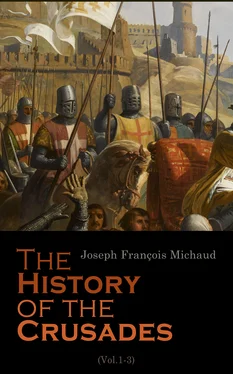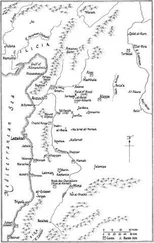At the same period, towards the middle of the eleventh century, Robert-le-Frison, count of Flanders, and Berenger II., count of Barcelona, resolved likewise to expiate their sins by the voyage to the Holy Land. The latter died in Asia, not being able to support the rigorous penances he had imposed upon himself. Robert came back to his dominions, where his pilgrimage caused him to find grace in the eyes of the clergy, whom he had wished to plunder. These two princes had been preceded in their pilgrimage by Frederick, count of Verdun. [29]Frederick was of the illustrious family which was one day to reckon among its heroes Godfrey de Bouillon. On setting out for Asia, he renounced earthly grandeur, and gave up his county to the bishop of Verdun. Returned into Europe, he resolved to terminate his days in a monastery, and died prior of the abbey of St. Wast, near Arras.
The weak and timid sex was not deterred by the difficulties and the perils of a long voyage. Helena, born of a noble family of Sweden, quitted her country, which was buried in idolatry, and travelled on foot into the East. When, after having visited the holy places, she returned to her country, she was sacrificed to the resentment of her relations and her compatriots, and gathered, says an old legend, the palm of martyrdom. [30]A few of the faithful, touched with her piety, raised a chapel to her memory in the isle of Zealand, near a fountain, which is still called the Fountain of St. Helena. The Christians of the North for a long time went in pilgrimage to this island, where they contemplated a grotto which Helena had inhabited before her departure for Jerusalem.
Among the celebrated pilgrims of this age, we observe the name of Robert II., duke of Normandy, father of William the Conqueror. History accuses him of having caused his brother Richard to be poisoned. Remorse urged him to make the pilgrimage to Palestine; and he set out accompanied by a great number of knights and barons, bearing the scrip and staff, walking barefoot, and clothed in the sack of penitence. He attached, he said, more value to the pains he suffered for Christ’s sake than to the richest city of his dukedom. On his arrival at Constantinople, he despised the luxury and the presents of the emperor, and appeared at court in the guise of the humblest of the pilgrims. Having fallen sick in Asia Minor, he refused the services of the Christians of his suite, and caused himself to be carried in a litter by Saracens. Meeting a pilgrim from Normandy, the latter asked him if he had any message that he could deliver for him to his country. “Go and tell my people,” said the duke, “that you have seen a Christian prince being carried to Paradise by devils.” When he arrived at Jerusalem, he found a crowd of pilgrims, who, not having the means of paying the tribute to the infidels, awaited the arrival of some rich lord who might deign, by his charity, to open for them the gates of the holy city. Robert paid a piece of gold for each of them, and followed them into Jerusalem amidst the acclamations of the Christians. During his sojourn here he caused himself to be remarked for his devotion, and still more for his charity, which he extended even to the infidels. As he was returning into Europe, he died at Nicea, in Bithynia, regarding only the relics he had brought with him from Palestine, and regretting that he had not finished his days in the holy city.
The greatest blessing for the pilgrims, and that which they demanded of Heaven as a reward for their labours and fatigues, was to die, like Jesus Christ, in the holy city. When they presented themselves before the holy sepulchre, they were accustomed to offer up this prayer: “Thou who died for us, and wast buried in this holy spot, take pity of our misery, and withdraw us at once from this valley of tears.” History tells of a Christian, born in the territory of Autun, who, on his arrival at Jerusalem, sought death in the excess of his fastings and mortifications. One day he remained a long time in prayer on the Mount of Olives, with his eyes and his hands raised towards heaven, whither God seemed to call him. On his return to the hospital of the pilgrims, he cried three times, “ Glory to thee, oh God! ” [31]and died suddenly in the sight of his companions, who envied him his fate, and believed themselves witnesses of a miracle.
The inclination to acquire holiness by the journey to Jerusalem became at length so general, that the troops of pilgrims alarmed by their numbers the countries through which they passed, and although they came not as soldiers, they were designated “ the armies of the Lord .” In the year 1054, Litbert, bishop of Cambrai, set out for the Holy Land, followed by more than three thousand pilgrims from the provinces of Picardy and Flanders. [32]When he began his march, the people and the clergy accompanied him three leagues from the city, and with eyes bathed in tears, implored of God the happy return of their bishop and their brethren. The pilgrims traversed Germany without encountering any enemies, but on reaching Bulgaria, they found none but men who inhabited the forests and subsisted upon plunder. Many were massacred by these barbarous people, and some perished with hunger in the midst of the deserts. Litbert arrived with much difficulty at Laodicea, embarked with those who followed him, and was cast upon the coast of Cyprus by a tempest. He had seen the greater part of his companions perish, and the remainder were nearly sinking under their various miseries. Returned to Laodicea, they learnt that still greater dangers awaited them on the route to Jerusalem. The bishop of Cambrai felt his courage abandon him, and believed that God himself was opposed to his pilgrimage. He returned through a thousand dangers to his diocese, where he built a church in honour of the holy sepulchre, which he had never seen.
Ten years after the voyage of Litbert, seven thousand Christians, among whom were the archbishop of Mayence, and the bishops of Spires, Cologne, Bamberg, and Utrecht, set out together from the banks of the Rhine, to repair to Palestine. This numerous caravan, which was the forerunner of the Crusades, [33]crossed Germany, Hungary, Bulgaria, and Thrace, and was welcomed at Constantinople by the emperor Constantine Ducas. After having visited the churches of Byzantium, and the numerous relics which were the objects of the veneration of the Greeks, the pilgrims of the West traversed Asia Minor and Syria without danger; but when they approached Jerusalem, the sight of their riches aroused the cupidity of the Bedouin Arabs, undisciplined hordes, who had neither country nor settled abode, and who had rendered themselves formidable in the civil wars of the East. The Arabs attacked the pilgrims of the West, and compelled them to sustain a siege in an abandoned village; and this was on a Good Friday. On such a sacred day, the pilgrims even who had arms employed them with much hesitation and scruple. Enclosed within the ruins of an old castle, they resisted for a time, but on the third day famine compelled them to capitulate. When they came to the arrangement of the conditions of the peace, there arose a violent quarrel, which was near leading to the massacre of all the Christians by the Arabs. The emir of Ramala, informed by some fugitives, came happily to their rescue, delivered them from the death with which they were threatened, and permitted them to continue their journey. As the report of their combats and their perils had preceded them, their arrival created a great sensation in Jerusalem. They were received in triumph by the patriarch, and conducted, to the sound of timbrels and by the light of torches, to the church of the Holy Sepulchre. During their abode at Jerusalem, the misery into which they were fallen excited the pity of the Christians. They could not visit the banks of the Jordan, or the places most renowned in Judea, as these were all now infested by the Arabs and exposed to their incursions. After having lost more than three thousand of their companions, they returned to Europe, to relate their tragical adventures, and the dangers of a pilgrimage to the Holy Land. [34]
Читать дальше












